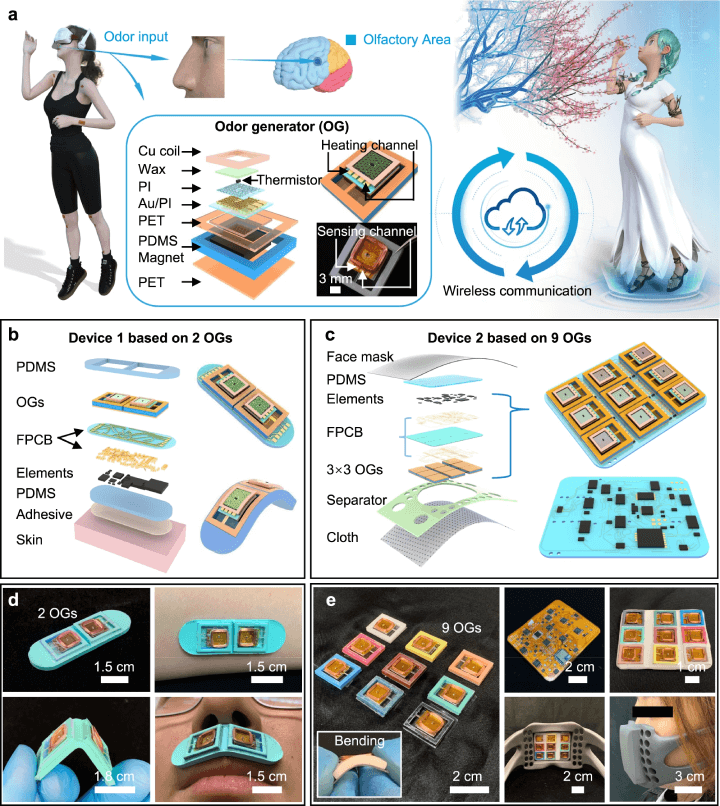The Future of VR: Smelling in Virtual Reality
24-05-2023 | By Robin Mitchell
The idea of being able to smell in VR has been around for ages, but it has only been a recent development by researchers that may actually make this practical. Researchers recently published a paper in Nature by researchers from Beihang University and the City University of Hong Kong provides some groundbreaking insights into this topic. What challenges does smelling in VR present, what did the researchers develop, and how could it provide users with new experiences?
What challenges do smells in VR present?
Moving on to the challenge of recreating odours, it's important to understand the complexity of the human nose. The human nose is a marvel of nature, arguably one of the single most sensitive organs in the body. Scientists believe it's capable of distinguishing an astonishing array of over 1 trillion unique odours, with numerous compounds that can be detected at the parts per million level. This demonstrates the great degree of sensitivity that the human nose offers. However, replicating this ability artificially is a monumental task, as many odours are chemically unique and synthesising these compounds in real-time is far from practical.
Trying to recreate the human nose has presented countless challenges, and the idea of a practical robotic nose is still yet to be developed. It is possible to create sensors that can detect specific compounds, but trying to create a generic smelling device capable of distinguishing between any two different odours is no small feat.
Understanding the complexity of recreating the human nose requires a deep dive into the science of olfaction. Our sense of smell? It's a chemical sense. This means it's triggered by chemical compounds. When we inhale, odorant molecules enter our nostrils and bind to specific receptors on olfactory neurons. Each neuron expresses only one type of receptor, and each receptor can detect a limited number of odorant substances. The combination of neurons that fire for a particular odorant forms a sort of 'smell code' that our brain interprets as a distinct smell. This intricate system allows us to distinguish a vast array of odours, and replicating it artificially is a monumental task.
Recent advancements in human-machine interfaces have underscored the significance of human sensory feedback, including vision, audio, and haptics. These interfaces have found applications in a variety of fields, such as entertainment, medical treatment, and VR/AR. However, one sensory aspect that is often overlooked but plays a crucial role in human perceptual experiences is olfaction. Olfaction, or the sense of smell, is as important as visual and auditory feedback. It influences many aspects of our daily lives, from building relationships to choosing preferred foods and even alerting us to potential dangers. Despite the progress in chemistry, biology, and neuroscience, research in olfaction feedback/generating is still in its infancy. Current olfaction-generating technologies are often bulky and inefficient, limiting their application fields. Therefore, there is a need for new wearable olfaction interfacing technologies that are miniaturised, lightweight, and flexible.

Next-Generation Immersive Social Media Online Metaverse Entertainment Platform.
But what about recreating odours? It's like trying to paint a masterpiece without ever having seen the original. Just as creating a robotic nose is complex, so too is the task of recreating odours. Again, it is perfectly possible to create a device that can produce an odour on demand, but to have that device create any odour is currently impossible. This primarily comes down to the fact that many odours are chemically unique, and trying to synthesise these compounds in real-time is far from practical.
Recreating odours artificially involves synthesising the specific chemical compounds that trigger our olfactory receptors. This is a complex process, as many odours are composed of a mix of different compounds, each contributing to the overall scent. Additionally, the concentration of each compound can significantly affect the perceived smell. For example, a rose's scent is not due to a single compound but a mix of many, including geraniol, nerol, and phenylethyl alcohol. To recreate the smell of a rose, one would need to synthesise each of these compounds and combine them in the right proportions. This is a challenging task, especially considering the need for real-time synthesis in a VR setting.
If this problem could be solved, it would present numerous exciting opportunities, especially in VR, where headsets could also provide a smelling experience. Whether it is rain in a forest, the winds of a desert, or the many BBQs at a festival, simply seeing and hearing isn’t enough for a truly immersive experience; being able to smell massively enhances an experience. This is also important for the formation of memories and the triggering of nostalgia.,
Of course, smelling systems in VR are yet to be developed, and while some attempts have been made, none thus far have been able to create a device that can deliver odours at notice.
In a recent study, a set of materials selection, device designs, integration schemes, and system layouts were reported for wirelessly controlled olfaction interfaces. These interfaces incorporate arrays of millimetre-scale odour generators (OGs) in thin, soft, and flexible sheets of electronics. The wearable formats of the olfaction interfaces are devised to be mounted directly on the skin surface above the lips or integrated into face-mask-based electronics. This design can establish a bridge between the electronics and users for broad application fields ranging from immersive VR/AR experiences to message delivery towards disabled users, to emotion control and to medical treatment.
Researchers create odour generator for enhanced VR experiences
Recently, researchers from Beihang University and the City University of Hong Kong published a paper in Nature describing a new odour generator that could help to improve VR experiences. In the paper, two different devices were published, one device that is attached under the nose and one that is worn as a mask, but of the two, the nose device is of far more interest due to the fact that it could potentially be retrofitted to existing VR systems.
To make the system work, the device incorporates an odour-containing compound suspended in wax, effectively making it a scented candle. At the same time, a small tiny element is placed around the wax that quickly heats up when current is applied. When heated, small quantities of the wax are vapourised, allowing the odour to quickly be detected, taking only 1.44 seconds.
So far, the researchers have been able to create 30 different scents, including pineapple, rosemary, and ginger. The researchers also developed a durian scent, popular for its rotten flesh smell, to demonstrate that not only pleasant smells can be synthesised. The researchers then demonstrated how flowers can be smelt in VR, with the system activating when an object of interest is in close proximity to the wearer’s nose.
Optimisations in materials selection, device design, power management, and mechanical optimisation of the OG guided by a series of theoretical and experimental efforts enable the OG to exhibit high efficiency in operation, rapid response time, and accurate in temperature control for the olfaction interfaces.
For instance, the investigation of the B value of the thermistors, power inputs of the thermal actuators, and lift displacements of the actuation cantilever in the mechanical actuators can guide us to realise excellent electrical performance for the OGs in terms of working efficiency, power consumption and response time.
The concept of 'optimisations in materials selection, device design, power management, and mechanical optimisation' might seem complex, but it essentially refers to the process of refining the different components of the odour generator (OG) to improve its performance. For instance, the 'B value of the thermistors' refers to a property of the thermistors used in the OG that affects their temperature sensitivity. By carefully selecting thermistors with the right B value, the researchers can ensure that the OG responds accurately to changes in temperature. Similarly, 'power inputs of the thermal actuators' refers to the amount of electrical power supplied to the components of the OG that generate heat. By optimising this, the researchers can ensure that the OG operates efficiently, using as little power as possible while still generating the necessary heat to vaporise the odour-containing compounds.

a) The schematic diagram reveals the skin-integrated, wireless olfaction interface, providing olfaction feedback for immersive VR experiences with an exploded view of the OG depicted in the frame. b) Exploded-view illustrations showcase Device 1, a skin-integrated format featuring two OGs (b), while Device 2 is a flexible face mask platform with 9 embedded OGs (c). d) Optical images demonstrate the skin-integrated olfaction interface (Device 1) securely mounted on curved human skin, even during bending mechanical deformation. e) Optical images display the face mask-based olfaction interface (Device 2) equipped with 9 OGs, capable of generating 9 distinct original odours. The details of circuit design, device layout, and assembled face mask are prominently presented.
Expanding the Horizons of VR and Beyond
The advent of these compact, wireless olfactory interfaces could revolutionise various sectors. In VR, they could bring the overlooked sense of smell into play, creating more realistic and engaging experiences. They could also aid in medical therapies, such as sensory rehabilitation for anosmia patients, or creating therapeutic environments for mental health treatments.
Moreover, the food and beverage industry could utilise these interfaces to enhance tasting experiences or attract customers. However, as we venture into this new territory, we must also consider the ethical implications and potential health risks. As this technology evolves, these are questions that researchers and policymakers will need to address.
How could this system provide new experiences?
While the device developed is somewhat crude, it demonstrates how future smell systems may be based on replaceable cartridges, providing users with a whole array of different scents. By combining such systems with VR, users can massively enhance their experiences, helping to form memories thanks to the activation of scent. Furthermore, smelling the same odours in life can help to induce nostalgia, providing fond memories.
This system may also be highly beneficial to those who are unable to travel, especially for those with disabilities. For example, many countries around the world have famous festivals in the streets (Brazil and Spain are prime candidates for this), but these involve very large crowds and are unlikely to be accessible to those with motor issues or those who have special access requirements (such as ramps). By combining VR with odour simulators, those who are unable to attend will be able to have a far more immersive experience of such areas.
Overall, what the researchers have developed is truly exciting, and with more refinement, it could become a genuinely practical device. MEMS technologies could be the key that unlocks the door to a new world of sensory experiences, especially if odour compounds can be concentrated and miniaturised. Thus, a single chip could provide thousands of smells and be cheap enough to swap out when empty.

